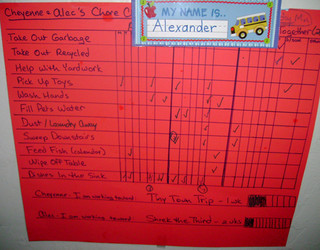When I talk about teaching your children responsibility with other parents, I’m often met with an eye roll and a sigh. Of course, everyone knows that it’s important to raise a dependable child, but actually doing it can be filled with conflict and tension. The thing that most people don’t understand is that, on the whole, it does not have to be that way. It is possible to live in a family where helping out is just as normal for our kids as playing video games or listening to an iPod. It’s all in the approach.
A man who becomes conscious of the responsibility he bears toward a human being who affectionately waits for him, or to an unfinished work, will never be able to throw away his life. He knows the “why” for his existence, and will be able to bear almost any “how.” -Victor Frankl
Some Assumptions
- Most people, including children, don’t like conflict.
- Most people want choices and dislike being bossed around.
- Most people feel good when they do real work that helps someone else out.
- Parents are not dictators.
Using a Chore Chart to Promote Responsibility
Chore charts can be used with children as young as two or three years old and all the way through elementary school. The earlier it is introduced, the easier it will be for us and our kids to actually use it as a motivator to shape responsible behavior.
How to Introduce the Chart
The way I introduce the idea of using a chart is this:
1. Discuss why everybody in the house has certain things they are responsible for and what would happen if things did not get done. I use concrete examples and remember not to blame or come across as argumentative.
2. Ask the child if he has any ideas how to get things done without arguing.
3. If he does not think of using a chore chart, I “come up with” the idea myself.
4. Explain that the chart will help him remember what jobs need to be done and that using it will keep me from always “having to remind him.”
5. Brainstorm with the child to come up with things that need to be done around the house.
6. Ask what he would be willing to do. This is also when I point out that sometimes people just have to do some things they don’t enjoy very much. Decide on the jobs he will do and when they will be done.
7. Discuss rewards/payments for some or all of the chores.
Creating the Chore Chart
Chore charts can be all text, only images or a combination of both, depending on the child’s reading ability. The younger the child, the simpler and shorter the chart should be. I would limit the number of chores to one or two very simple and relatively fun tasks when starting out with preschoolers. Older children can handle seven to ten chores each week.
Making a chore chart is easy and children can help in its creation. This helps them buy into using it willingly instead of having it thrust upon them by a “bossy” mom. To make the chart, we need to make a table with boxes along the top for days of the week and boxes down the left side of the table for the chores. My kids liked to decorate their charts with stickers, glitter and drawings. If you can, once the chart is finished, laminate it so it will last.
Sample chores could be: helping with laundry, put toys away, clean up room, feed dog; give greenies dog treat, or empty trash.
Putting It to Use
Each time my son completed a job on the chart, he made a check mark in the box so I would know he was done with it. Each week I would “evaluate” his work and provide guidance on ways to improve. Non-judgmental and matter-of-fact constructive criticism is easier for anyone to take. Remember to offer praise and thanks for a job well done. I often tell my son how much doing his jobs helps me out and thank him for doing it without complaining. This works wonders on his willingness to help out in other ways, too.
Rewards
Once he has fulfilled his responsibility and has earned his reward/payment, it is my responsibility to deliver it on time. This models responsible behavior that he is sure to notice.
Using this method from the time my children are very young has worked well for my family. By the time the kids are in their teens, they are volunteering to do the dishes and other chores just because the jobs need to be done and they know how much I appreciate their help. Try it. You might be pleasantly surprised with the results.
About the Author
Jane Warren writes about practical parenting issues, travel, and pets. Her website, www.pamperthepets.com, provides tips and reviews of important pet products, such as bulk puppy pads. She enjoys teaching others about techniques that have worked for her and hearing about the successes of others. In her spare time, you may find her traveling or scuba diving around the world.
Earnest Parenting: help for parents who want responsible children.
Image courtesy of maryfrancesmain via Creative Commons license, some rights reserved.



A great idea and one we have implemented for our 5 year old with a few simple chores. He actually enjoys doing them!